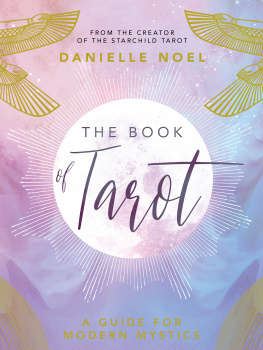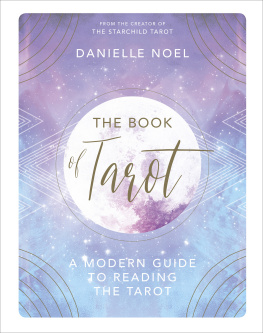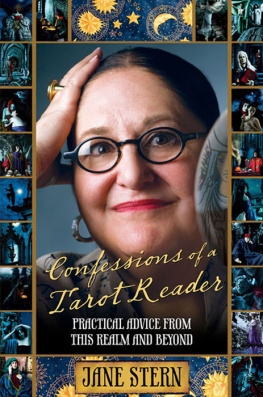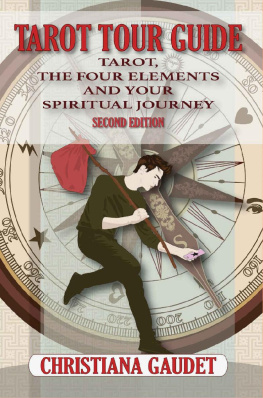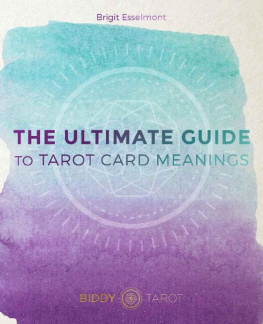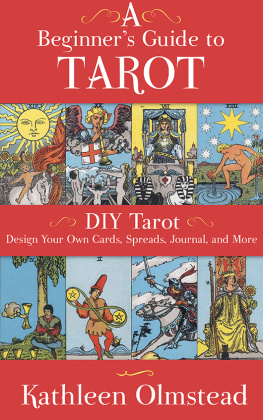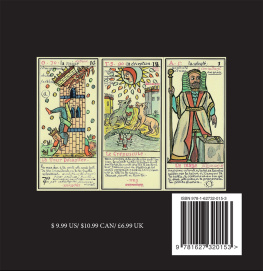The Book of Tarot: A Guide for Modern Mystics
Copyright 2018 by Danielle Noel. All rights reserved.
No part of this book may be used or reproduced in any manner whatsoever
without written permission except in the case of reprints in the context of reviews.
Andrews McMeel Publishing
a division of Andrews McMeel Universal
1130 Walnut Street, Kansas City, Missouri 64106
www.andrewsmcmeel.com
ISBN: 978-1-4494-9469-8
The Book of Tarot: A Modern Guide to Reading the Tarot was
first published in the United Kingdom in 2017 by Ebury Press,
a division of Penguin Random House UK.
Library of Congress Control Number: 2017953089
Editor: Melissa Rhodes
Art Director: Holly Swayne
Production Editor: Elizabeth A. Garcia
Production Manager: Tamara Haus
Digital Production: Kristen Minter
DISCLAIMER
The information in this book has been compiled by way of general guidance in relation to the specific subjects addressed, but it is not a substitute and not to be relied on for medical, health care, pharmaceutical, or other professional advice. The author and the publishers disclaim, as far as the law allows, any liability arising directly or indirectly from the use or misuse of the information contained in this book.
ATTENTION: SCHOOLS AND BUSINESSES
Andrews McMeel books are available at quantity discounts with
bulk purchase for educational, business, or sales promotional use.
For information, please e-mail the Andrews McMeel Publishing
Special Sales Department: .
coNtents
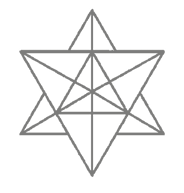
INTRoDUCTIoN
This book is dedicated to all of the mystics and seekers who wish to explore their own intuition and light. It is also made for those who are new to the Tarot, offering a gentle yet honest approach to its archetypes and meanings. The definitions that you will find throughout the following chapters result from my years of working with this sacred tool (while also being somewhat obsessed with the mystical and healing arts), refined down to a family of keys to help you cultivate more magic and medicine in your life. They have been written from my heart to yours, to give you an easy-to-use, practical guide to this ancient, wise, and intuitive practice. Inspired by sacred symbology, the Akasha, and the fabric of our universe, each card in this book functions as a tiny gateway into inner worlds for you to explore.
Maybe youre at a crossroads, have questions, or want to connect with new sparks of inspiration. Perhaps youve wanted to try out the Tarot but have heard mixed reviews on what it actually does and how it all works. My hope with this book is to bring a soulful awareness to the incredible value of the Tarot as a device for self-discoveryas a confidant, a teacher, or a familiar friend who is always at hand. With these pages, may you unveil some of your own moments of truth while embarking on the endless potential of your journey with the cards.
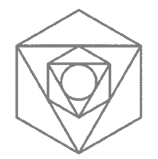
A Sense Of WOnder
What I love about the Tarot can be expressed by that same sense of wonder I often felt as a child. When I discovered my first deck, I knew I had a great mystery on my hands. The waxy veneer of the cards stuck together, the edges were frayed, and there was a faint, familiar perfume lingering in the box. This encounter was like unearthing some lost, ancient relic. Up until that point, Id been the little girl who was constantly in search of a doorway to another world, whether in the form of the rabbit holes in my childhood garden or the dusty, old books in my local library (which, to my imagination, must have contained obscure manuals for time travel).
Over the years, as I became more familiar with the Tarot, I gradually came to learn that somewhere, hidden within the pictures of all the oddly positioned swords and overflowing cups, was the story of my own life reflecting backthat the cards were miniature entry points into an inner world. Suddenly, that missing doorway appeared, and I was able to peer into a new space of sensitive, intuitive nuances that helped me strengthen and unlock my own healing and awareness.
With time, I came to realize that the Tarot was so much more than a simple deck of cards, and, after slowly putting the pieces of this venerable puzzle together, I found myself wanting to create a deck of my own. While I knew there were varying opinions on where and how the Tarot actually originated, for the sake of storytelling, I decided to celebrate some of its more mysterious chapters. I saw it as an encoded language steeped in sacred myth, with hidden clues woven throughout an ancient narrative. I imagined it being carried in secret, traveling over miles of dust, sand, and sea; found in the caves and dwellings of alchemists, mystics, witches, and wizards. I saw its magic reflected in classical paintings, worldly sacred sites, occultism , biblical and gnostic symbols, and so many other sources that it was actually mind-boggling. This was the stuff of legend.

A Brief HistOry Of Time
The Tarot is one of those mysterious items that has long been attributed with a rich and controversial history. I have always imagined its story preserved within an old, leather-bound encyclopedia, with a centurys worth of footnotes filling its vibrant pages. For now, I am going to offer a very brief summary of this timeline, which barely even begins to scratch the surface. This is a story that could take a lifetime to unearth, if you were willing to dig deep enoughwhich just makes it all the more interesting and alluring.
The very word Tarot suggests numerous possibilities as to the decks origins. There are those who associate it with the Hebrew word Torah ; the Latin rota , meaning wheel; the Arabic Tarah or Turuq , which refer to four ways; as well as the Egyptian words Tar (path) and Ro (royal), which describe a Royal Path, perhaps translating into an allegorical journey .
The strongest evidence connects the Tarot to the Italian Tarocchi or Tarocco, which refers to the original renditions of playing-card games that appeared in Europe sometime during the 15th century. There is even a river in northern Italy called the Taro, which may have been exactly where the cards materialized, though no one knows for certain. Perhaps initially created as a set of paintings for nobles, the cards went through several subtle variations while they seemed to grow in popularity, eventually forming the blueprint for what we now know as common playing cards.
Not long after the cards spread from Italy into other parts of Europe, a new system of Tarot emerged in France, in the port town of Marseilles. This was the Tarot of Marseilles , which formed the basis of many later decks. This revolutionary Tarot, rich with esoteric symbolism, reached a new wave of occultist practitioners and shifted the focus toward new schools of thought.

